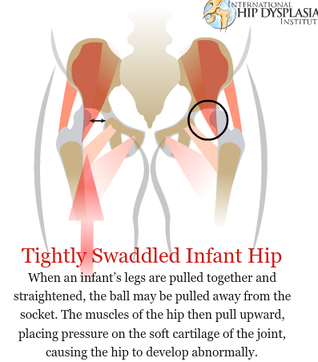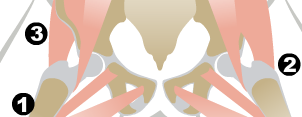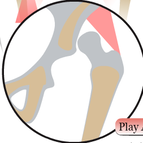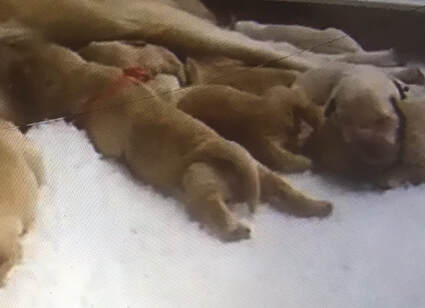If the teres ligament is damaged, the round head of the femur is not held snugly in the cup of the hip joint. Because normal development of the hip is a response to the biomechanical forces on the socket during growth of the puppy, abnormal position of the ball in the socket can result in damage to the rim of the hip socket and the development of hip dysplasia. Proper development of the hip joint depends critically on the head of the femur being properly seated in the center of the hip socket. (You can read more about this in "The 10 most important things to know about canine hip dysplasia.")
How is the teres ligament damaged? Some information about the cause of hip dysplasia in humans can illustrate.
The hip sockets of dogs and humans are very similar. The head of the femur is firmly held in the hip socket by muscles and tendons. These are so tight, and the teres ligament so short, that at birth, the legs are held apart and slightly bent. If the legs are pulled together, the head of the femur is pulled away from the hip socket as in the illustration below. This puts abnormal stress on the teres ligament and can cause damage that results in laxity in the hip joint.
The movement of the legs that puts stress on the teres ligament is called extension and adduction - straightening the legs and pulling them together. This is the reason why hip dysplasia is more common in cultures where babies are tightly swaddled than in those that carry infants on the back with the legs around the mother's waist. With this knowledge, new mothers are advised not to wrap up newborns like little burritos but instead swaddle them loosely with room for spread legs and bent knees.
The hips of newborn puppies are similar to those of humans. The hip joint at birth is mostly cartilage, and it will be converted to bone over the first 5 months of growth. At birth, the teres ligament is very short and strong, and it becomes longer as the puppy grows, allowing more freedom of movement in the joint. Also like humans, a newborn puppy on its back will generally hold the legs apart and bent.
However, when a newborn puppy is placed on a surface with inadequate traction, its feet slide right out from under it just as yours do if you walk on ice in street shoes. In the case of the puppy, it tries to walk by pushing backwards with the hind legs, and if traction is not adequate, the legs and even the feet will extend to the maximum. You will notice this happening if you watch puppies in the whelping box and see the pads of the rear feet facing the sky instead of the floor. A puppy (and you) moves forward by pushing backwards. If there is inadequate traction, the legs will extend and adduct, exactly the position that results in damage to the teres ligament in human babies.
Most people that I ask tell me that their puppies are whelped on some material that has good traction. Vet bed, rubber mats, carpet, whelping pads, and many other things are routinely used in whelping boxes. I have tested all of them and more, and none provided adequate traction for every breed I tested or for the duration of the first few weeks of life as the puppy gains weight.
How did I evaluate traction? I looked for the single give-away - extension and adduction of the back legs, looking like little puppies on popsicle sticks. If I saw pads facing the sky, the mat failed.
To be fair, I did find one mat that provided terrific traction. It was made from coconut fibers sticking straight up like broom bristles. It provided great traction, but it also took the delicate skin off the newborn puppy's foot pads. That too was considered a fail.
Here are some examples of what I observed watching puppies, and there are many similar examples to be seen in the volumes of puppy videos on YouTube if you care to browse (try searching on "newborn puppies nursing or crawling).
If you've been paying attention, you are probably wondering if the puppies in your whelping box ever reveal their rear foot pads because they're facing the sky instead of the ground. To give you some practice spotting the extended-adducted leg position (before you dash off to look at your photos!), check out these very busy puppies. At a casual glance, they look like they are getting around pretty well. But watch closely; these pups on this surface would fail the traction test.
I have made observations of hundreds of litters of puppies on all manner of surfaces, and so far the ONLY surface that provided adequate traction for all puppies (i.e., back legs were never fully extended and straight) was that coconut fiber mat that could take the skin right off the bottom of your feet. These are the mats you see inside large hotels in areas where it snows, so you can brush the snow off the bottom of your shoes with the bristles. They're designed to be harsh.
I've been working on solving this problem for the last few years. Finally, after fussing and fiddling with various types of surfaces, I have finally come up with one that prevents slipping and the damage to the teres ligament that can result in hip dysplasia. I am currently testing this surface on litters of various breeds of dogs, and so far it has worked well. I need to look at many more breeds and also observe the puppies over the first several weeks when their weight increases dramatically with growth. Of course, the acid test will be seeing if these puppies have sound hips, so some of these puppies will be scored at four months using PennHip, which quantifies hip laxity with the "distraction index." Will this ultimately solve the hip dysplasia problem in dogs? Time will tell. But I'm very optimistic.
|
|
*** Visit our Facebook pages ***
ICB Institute of Canine Biology
...the latest canine news and research
ICB Breeding for the Future
...the science of animal breeding











